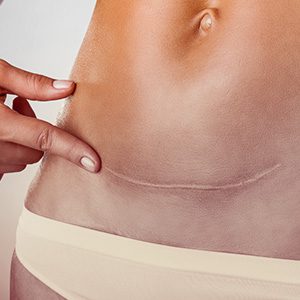
Why is there scarring after surgery or skin trauma?
Scarring appears post-surgery or from skin trauma, as the tissue is trying to repair the wound. The body has beautiful techniques to heal and close the wound with collagen (a connective fiber that gives your skin strength and flexibility) to connect and weave the broken tissue back together. Apart from collagen other substances are deployed and create a scab at the injured site. The scab is the bodies defense against germs and pathogens while it’s trying to heal. Upon repair, the scab will dry up and fall off, and left in its wake is a scar. Scars are multicolored and can be brown, silver, or pink. It is important to note that scars are a natural part of the body’s healing process after injury.
What variables affect the appearance of scars?
The manner in which a scar manifests depends on a couple of factors including:
- The depth of the injury.
- The size of the wound.
- The location of the wound — is it in an area with or without a good blood supply?
- The individual’s sex, age, genetics, and ethnicity.
Scarring will not completely go away, but with a qualified and board-certified plastic surgeon like Dr. Schutte at Front Range Plastic And Surgery, we can help diminish the appearance.
What kind of scarring does the scar revision procedure address?
Our scar revision procedure can help reduce the appearance of the following types of scars:
Keloid – A keloid scar typically appears after an aggressive healing process and develop when there are multiple injuries to the same site.
Hypertrophic – These are raised scars, usually red in appearance, and trace the boundary of the the injury.
Contractures – This type of scarring is a result of burned tissue. These scars are notorious for tightening as they heal and can impair movement. Because of the nature of these scars, they often go deeper and affect the muscles and nerves.
Facial – Facial scars are seen as a result of healed acne. Acne can leave deep pits and an uneven texture to the skin.

What techniques are used in scar revision procedures?
Z-plasty – The Z-plasty is a technique often considered for contracture scars, as it can relieve the tension that happens during healing. This technique can modify the scar by redirecting it towards a natural fold in the skin or places where there is the least tension. Contracture scars can also be lengthened in this technique. The Z-plasty gets its name from the two triangular flaps of equal dimension that are then converted and rearranged in a “Z” pattern.
Skin grafts – If you have an area that is largely scarred, a skin graft could help address the injured site and help bring function back affected areas. A skin graft will likely be an inpatient procedure performed at the hospital, and it can take anywhere from a couples weeks to months to heal. Grafting will take skin from a healthy part of the body or from a donor, and it will be placed to cover the damaged and scarred area.
Flap surgery – Flap surgery is similar to grafting, however, it will take an entire portion of tissue complete with the underlying fat and blood vessels and move it to the injured site. The blood vessels from the new tissue are placed in the injured tissue and undergo a microvascular surgery for an almost immediate blood supply to support healing.
All of these procedures help improve the appearance of severely scarred patients, but do not completely remove the scar. In skin grafting and flap surgery, the skin that is grafted can be mismatched in color as well as texture.
Scars are tough skin conditions to treat, so try and stay patient in the healing process. Most patients see scar reduction within the first year.
Front Range Plastic And Surgery
At Front Range Plastic And Surgery, we want to help you look and feel your best. If you have scarring from burns or surgery, we may have the perfect scar reduction technique for you.